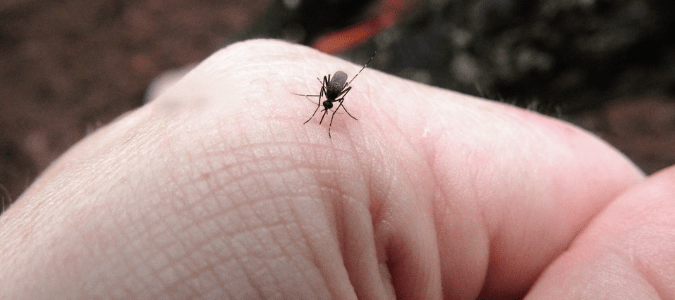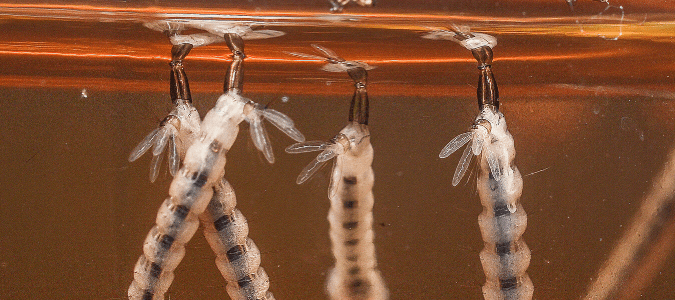If you spend any amount of time at all outside, you are going to encounter mosquitoes. That is just a fact of life. However you might be wondering why you are suddenly seeing a smaller version flying around inside your house. These tiny bugs are mosquitoes, but not necessarily the types that you might recognize.
Typically, you will find Southern house mosquitoes, which are light brown. Smaller varieties are not native to the United States and have distinctive differences from their native cousins. And be warned: These types of mosquitoes, collectively known as Aedes mosquitoes, love to snack on humans.
And these bugs can bring more problems that a little sting on the skin. The Aedes varieties also carry viruses such as Zika, dengue, chikungunya and more.
This grouping of mosquitoes lays its eggs in any water source, which is why they are called “container breeders.” Even a quarter-inch of water is enough for these bugs to set up housekeeping and start laying eggs. In fact, one of them—the Aedes albopictus, or Asian tiger mosquito—was introduced to the U.S. when they hitched a ride on tire casings coming into the country. If you are noticing an increase of smaller mosquitoes around water sources, contact a licensed pest professional. Professionals will be able to assess the problem areas and suggest treatments.
These mosquitoes need the proteins in animal blood to reproduce. This is why Aedes varieties typically don’t travel too far away from their breeding site. Usually, they’ll only fly a half-mile or so. And though their choice of breeding grounds is one commonality, there are some differences in the types of climate they prefer.
Yellow Fever Mosquitoes
For instance, Aedes aegypti—also known as yellow fever mosquitoes—generally live in tropical and subtropical climates. But, they can also be found in some more temperate places. These mosquitoes are the main type of these flying insects that spread the dangerous viruses they can carry. In addition to carrying yellow fever, these mosquitoes can also transmit dengue fever and the Zika virus.
Asian Tiger Mosquitoes
Aedus albopictus can be found in places with cooler temperatures. They need proteins in blood, like the Aedus aegypti variety, but these mosquitoes typically prefer the blood of animals. Sadly, these mosquitoes will bite dogs. Because of this more varied diet, Aedus albopictus is less likely to spread Zika, dengue, chikungunya and other harmful, bloodborne viruses.
Australian Backyard Mosquitoes
Aedes notoscriptus (the Australian backyard mosquito) has also been spotted in the United States. If you suspect the tiny black bugs buzzing around your home or exterior might be one of this group, give a licensed pest professional a call. A professional can identify which of these pests you’re dealing with and come up with a mosquito treatment plan.
How To Catch Mosquitoes in Your House
If you are seeing mosquitoes around the home, a fly swatter or fly trap is a low-cost way to get rid of a few here and there. However, if you are seeing more than that, take a look in some of the places where they might thrive. They like to hide in dark, damp spots such as under sinks, in the laundry room or in closets. If you see evidence here that a mosquito brood is blooming, you will want to use a product that is appropriate for indoor use to control them.
Such products come in fogger, pump spray and aerosol formulations. The product should indicate if it is approved by the Environmental Protection Agency for use indoors.
Of course, making sure the pests never make it into your home is an even better plan for getting rid of mosquitoes in your house. Check your window screens and be sure you don’t have any holes or tears that are allowing mosquitoes to sneak in. And don’t forget to check mesh screens around your chimney, vents and doors as well.
Make sure the screens you are using now or to replace existing ones are at least 12 by 12 meshes per 25 millimeters. Or, you can purchase a coarser screen if you want to keep smaller biting bugs out as well. Also, if you have an outdoor porch or veranda, consider adding a screen door there as well to add another line of defense.
Mosquitoes love water and can breed in even a small amount. Therefore, it is important to make sure you don’t have any water sources that facilitate their growth. Check for standing water in your yard, in gutters and even in children’s outdoor toys. Change out pets’ water dishes and bird baths often. If, you have a swimming pool, keep it well-maintained with the proper chemicals or empty it if not in use.
Consider adding plants that naturally repel mosquitoes, such as lavender, basil, marigolds, eucalyptus, citronella and even catnip. For your decorative pond, add camphor tablets to take care of any lingering pests.
Even little pools of water on patio furniture or standing in a puddle in a carport can draw adult females and provide a home for eggs to grow and become little biters. A pest professional can assess any problem areas in and around your home. Then, they can recommend and perform a pest treatment plan that is suited to your specific needs.
How Long Can a Mosquito Live?
A mosquito’s life span varies by species, but they all have the same four-stage life cycle. They all begin life as eggs, which an adult female deposits either individually or as a “raft” of many eggs together. The eggs are placed either directly on the surface of water, on the edge or a water source or somewhere that gets rain runoff regularly.
The time a mosquito spends in egg form also varies by type and by temperature. Some eggs stay dormant for several years while they wait for the perfect hatching conditions! Others move to the next stage within a few days. Many mosquitoes spend the winter as eggs just waiting for the weather to change.
The next stage is the larval stage, which begins once the egg hatches. As you can see in the image above, most mosquito larvae hang from the surface of water because they need to be able to breathe air to survive. They have a tube called a siphon that runs from the posterior of the larva to the water surface and allows them to get the air they need. Larvae also eat microorganisms living near the surface. This allows them to grow through their stages in which they develop new exoskeletons. The larval stage lasts from four to 14 days.
Next up is the pupal stage. During this time, the mosquito doesn’t eat. It still breathes in air and it remains active by rolling or tumbling around to escape any predators by diving to deeper water. This stage lasts a shorter time, from 1.5 to four days. Then the mosquito sheds its skin and lets the new adult version out to rest on the water.
Adult mosquitoes emerge at different times. The males come out first, hanging out and waiting for the females to emerge. They die quickly after mating, so that occurs very soon after the females arrive. Most adult female mosquitoes live around two to three weeks. The mosquitoes that survive winter hideout in places such as attics, garages or culverts and can live up to six months.
Females need to feed before they can produce eggs, and they sometimes travel many miles to do so. Certain species go through this cycle several times, and others may lay eggs just once before dying.
With so many varieties of mosquitoes and different variables affecting their growth and prevalence, it’s important to get the right information to protect your family and your home. Contact a professional today to discuss your pest control options.
ABC Can Control the Mosquitoes on Your Property
If you’re looking for effective mosquito control, contact ABC Home & Commercial Services. We use a variety of strategies and products to treat these pests throughout their life cycle. This way, you and your family can be at ease when you’re at home.


